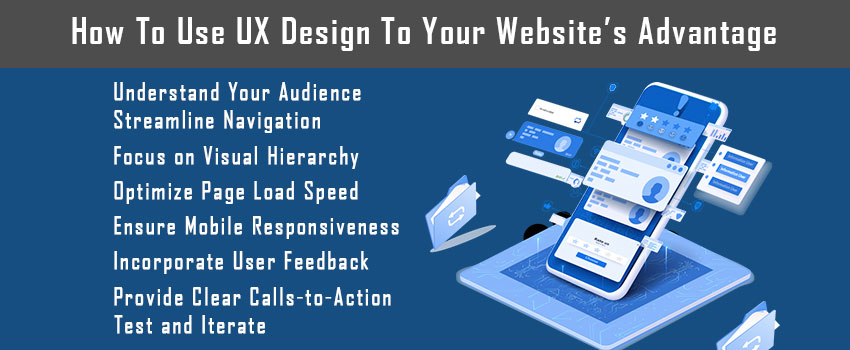Your website’s user experience (UX) is crucial to its success in the digital age since companies greatly depend on their internet presence. A well-designed website draws users in, maintains interest, promotes conversions, and builds brand loyalty. At Base Creative, we understand the importance of UX design in creating meaningful interactions between users and websites. In this guide, we’ll explore how you can leverage UX design to your website’s advantage.

Understand Your Audience: It’s critical to comprehend your target audience before beginning the design process. Please find out about habits, preferences, and problems by conducting user research. By understanding your audience’s needs, you can effectively tailor your website’s UX to meet their expectations.
Streamline Navigation: You can only expect users to easily navigate your website if the navigation is clear and straightforward. Simplify menu structures, use descriptive labels, and ensure consistency across all pages. Implementing breadcrumb navigation and search functionality can further enhance the user’s ability to find relevant information quickly.
Focus on Visual Hierarchy: Visual hierarchy helps users prioritize information and navigate content effortlessly. Use typography, color, and layout to emphasize essential elements such as headlines, calls-to-action, and key messages. You can increase readability and engagement by arranging content visually appealingly.
Optimize Page Load Speed: In today’s fast-paced digital landscape, users expect websites to load quickly. Slow-loading pages not only frustrate users but also impact search engine rankings. Optimize images, minify code, and leverage caching techniques to improve page load speed. Reducing bounce rates and increasing user satisfaction can be achieved by providing a quick and responsive experience.
Ensure Mobile Responsiveness: You must prioritize mobile responsiveness when designing your website because mobile devices are being used increasingly. Take a mobile-first stance to ensure your website works and looks great on various screens and devices. Responsive design not only improves usability but also enhances SEO performance.
Incorporate User Feedback: Seek out user feedback to pinpoint areas that need work and iteratively improve the UX design of your website. Get analytics data, administer surveys, and test your website’s usability to learn how people interact. Incorporate user feedback into iterative design cycles to create a user-centric experience.
Provide Clear Calls-to-Action: Desired actions, like making a purchase or subscribing to a newsletter, are guided toward effective calls-to-action (CTAs). Ensure that CTAs are prominent, visually distinct, and communicate the intended action. Use persuasive language and strategic placement to encourage conversions and drive engagement.
Test and Iterate: UX design is an iterative process requiring continuous testing and improvement. Heatmaps, user recordings, and A/B testing can all offer insightful information about the preferences and behavior of users. Continuously test different design elements and iterations to identify what works best for your audience and optimize accordingly.
In conclusion, your website’s success is greatly influenced by its user experience (UX) design. By understanding your audience, optimizing navigation, focusing on visual hierarchy, and incorporating user feedback, you can create a compelling user experience that drives engagement and achieves your business goals. At Base Creative, we’re passionate about helping businesses elevate their online presence through effective UX design. Call us to find out how we can help you develop a unique and effective website.
